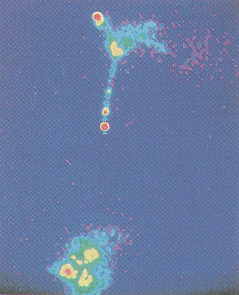

Since MERLIN began work in 1980, its images have helped shed light on the mysterious processes going on inside radio galaxies and quasars. High-resolution observations reveal that a typical radio galaxy or quasar has a bright, compact core from which issue two narrow "jets", which appear to impact on the twin lobes which have been known since the 1950s. Although not all sources show these features, it appears that the jets are transporting energy from the nucleus of the galaxy and depositing it in the lobes.

Radio image of the giant elliptical galaxy known as Messier 87 or Virgo
A. (US National Radio Astonomy Observatory; JL Nieto).
 Quasar 3C179, showing two lobes on either side of the core. One of the lobes is connected by a jet.  MERLIN image of the core and jet in quasar 3C273. |
How this energy is generated, and how it is transported, is a key problem in astrophysics, but most theorists agree that only a massive black hole can provide enough energy to power these objects. In simple terms, a black hole is a region of space in which the gravitational pull is so strong that not even light can escape from it. To power a quasar, a black hole would need to contain a mass a billion times that of the Sun. Material falling into the hole is heated to extremely high temperatures, emitting x-rays that can be detected by telescopes on board satellites. This release of gravitational energy can be more than ten times as efficient as nuclear fusion, the process that powers the Sun and the hydrogen bomb. By means not yet understood, some of this energy escapes from the nucleus along the jets and energises the lobes. Jets contain a mixture of charged particles and magnetic fields, which together produce powerful radio emission ideally suited for study with MERLIN. The physics is undoubtedly complex, and the continuing study of radio jets will be a major task for MERLIN in the 1990s. |